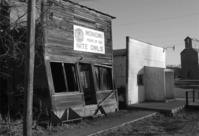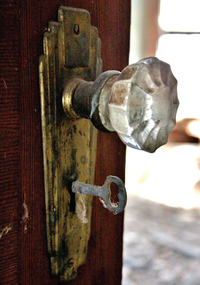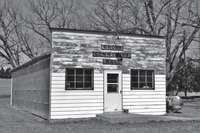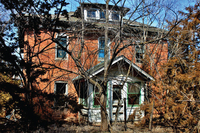Easter Sunday of 2012, not to be at home alone for the holiday, I set out towards Pickstown, S.D. into Nebraska as a friend told me of some abandoned structures that I needed to see for myself. A bit ironic I thought as I drove south into Nebraska that I’ve chosen not to be at home alone in place of exploring and walking through potentially abandoned structures, left alone to deteriorate until extinct. Possibly coming across once a community, now a ghost town of buildings that were at one time homes, churches or businesses.
Sometimes getting lost can have its rewards. After driving for what seemed like hours through winding gravel roads, I happened across an old wooden sign reading, “Lifestyles of the Poor & Unknown, Nebraska Inn Gross, NE ½ mile.” Well I’m in luck, there is a sign of life out here, well sort of! At the top of the hill I quickly reach the “city limits”, where the metal sign marking the community reads Gross, population 2. Across from the sign on this gravel road sat a two-story brick home, overgrown with trees and shrubs almost hidden. I parked my truck and set out to see what secrets this home could be hiding. The home on the outside looked solid but abandoned for some time, inside the home had floorboards stripped throughout creating a maze of hazards that I slowly navigated through. A few pieces of furniture remained, shredded by rodents for bedding as nature had reclaimed this structure. I continue down the hill into the town of Gross with only a few landmarks remaining, a restaurant/bar called the Nebraska Inn, and a home. A small Community Hall, an old cement bank vault sits next to a park and in the center of town stands a flagpole and an interesting water pump
next to a military marker.
Here is the history of Gross, Nebraska. According to Wikipedia the town got its start in 1891, when Ben Gross and his wife Matilda settled in the area opening a general store there and began to encourage visitors to stay and build a town. In anticipation of railroad that was to be constructed, a bustling town developed, Gross was home to multiple businesses, churches and factories, in addition to about 600 residents. The railroad ended up bypassing Gross, and there was an immediate exodus. There were two huge fires in Gross, one in 1900, and one in 1902 destroying most of the businesses, prompting even more residents to leave. And by the 1950’s it saw a big decline. As of the 2010 census, the village had a total population of two.
Today, the town is mostly empty but for a few notable exceptions, the vault located near the park is from the Gross State Bank, it’s one of two banks that used to be in Gross. It was built on the outside of the bank. The proprietor of the bank thought there would be less damage done to the structure of the bank if there was a robbery, and the vault was more accessible on the outside. And the military marker in the center of town is there because Gross used to be a part of the Fort Randall military reserve.
Like so many other towns in Nebraska, Gross was founded by people who believed the railroad would soon be built through the area. If the town was right on a railroad route, the trains would bring businesses, customers, residents, and visitors in droves. It was a kind of prospecting that paid off for some folks but left others living in towns that would never truly thrive. The town may not be thriving in the traditional sense, but there are always people here with the Nebraska Inn, as the restaurant serves some of the best burgers around, I have been told. The townsite has been mostly reclaimed by nature, but this little town refuses to become a ghost. On this day the lone two
residents were not home and the restaurant closed, I was not alone as four deer in a nearby lot grazing kept an eye on me throughout my time here and as I climbed back into my truck, looking at my rearview mirror, I watched as a cloud of dirt formed and the community, population two disappeared as I drove off in search of my next find.
The following year around Thanksgiving with my husband Ryan in hand we headed to Monowi, Nebraska population 1. Ryan had found this on the map in his usual manner of searching for areas for us to photograph and saw with Google earth that there were a lot of structures still standing. And once we arrived it did not disappoint, there was an abandoned church that sat just on the edge of the town with a partial gravel road leading up to it, whose empty pews are now filled with tractor tires, and stands opposite the decaying skeleton of a grain elevator. What would’ve been the business district sat a couple of standing and partially collapsed businesses at one time. I entered one that seemed to me it was a bar with a café or restaurant in it. I have to admit, I was a bit spooked by it as I originally thought that the carvings on the walls were put there by a cult of some kind only to learn later when I showed the picture to a friend and she said, “how cool is that and I love the brands on the walls.” Of course, it clicked for me that those were cattle brands probably put there at one time from the areas farmers and ranchers when it was a bustling community. There were many homes still standing but there are no more
streets as dried overgrown prairie grass has spread consuming the ground eliminating any signs of a path, we had to hike on foot to explore each one. It was obvious that some of the residents had left due to fire destroying their homes, others were caving into holes from abandonment and mother natures wrath. Yet one home abandoned still stood fairly solid and had so many belongings remaining. An old radio sat on a shelf with a couple of even older cameras, a mans jacket hung by a closet door. In the bedroom the bed remained still covered with blankets and boxes of books and other items filled most of the floor space. And a woman’s coat still on the hanger was centered on the far wall waiting for the owner to come back. Some of the windows were broke and part of the roof was beginning to sag, the little life still showing in the few belongings that have been untouched will eventually be lost and buried as time will tell and when mother nature takes her control and embraces the forgotten.
We spent hours walking around this spread out ghost of a community. The only sign of life that the Monowi road sign boasted a population of one, was the modern metal building with a sign reading, Rudy’s Library, next to it the lone resident home, but not at home on this day. And a white squat building with peeling paint, looking through the window hangs a sign, “Welcome To The World Famous Monowi Tavern, Coldest Beer In Town!” I chuckle at this as I had never heard of this town till Ryan found it, and it boasts a world-famous tavern. I would learn nearly a decade later that this is true. As we were not the first to find this almost lost town and we would not be the last, as Monowi and the sole resident has reached a bit of fame with interviews from television shows to other publications being the only survivor of a near ghost town.
I went to Wikipedia to once again provide the history of Monowi, Nebraska. Monowi is an incorporated village in Boyd County, Nebraska. Monowi was so named after the many wildflowers growing at the original site of the village. Monowi was platted in 1902, when the Fremont, Elkhorn and Missouri Valley Railroad was extended to that point. A post office was established in Monowi in 1902 and remained in operation until 1967. Monowi’s peak years were in the 1930s, when it had a population of 150. With several businesses including grocery stores, restaurants, and even a prison. Like many other small rural economies in the US heartland and throughout the Great Plains, it began to collapse after World War II, entire communities started to disappear. It lost its younger residents to cities that were experiencing growth and offering better jobs. And gradually, as farming conditions worsened and jobs were lost to automation, people started moving away in search of greater opportunity and those who stayed eventually passed away. The final funeral held in the over 100 year old Methodist wooden church was for Eiler’s father in 1960. Then the post office and last of the three grocery shops closed between 1967 and 1970, followed by the school in 1974. During the 2000 census, the village had a total population of two; only one married couple, Rudy and Elsie Eiler, lived there. Rudy died in 2004, leaving his wife as the only remaining resident. In this capacity, she acts as mayor, granting herself a liquor license and paying taxes to herself. She is required to produce a municipal road plan every year in order to secure state funding for the village’s four street lights. In addition, Eiler maintains the five thousand–volume Rudy’s Library, founded in memory of her late husband.
So, if you’re trying to navigate the winding gravel roads in Nebraska south of Fort Randall Dam or are traveling down Highway 12 that runs east and west through northern Nebraska, and you come across Gross or Monowi, stop, get out of your vehicle and stretch your legs. Take a look around and then go into the Nebraska Inn or the Monowi Tavern, get a cold drink or even a bite to eat. Both these sole survivors of once booming communities would love the visitors, and can you imagine the stories they must have to tell!






